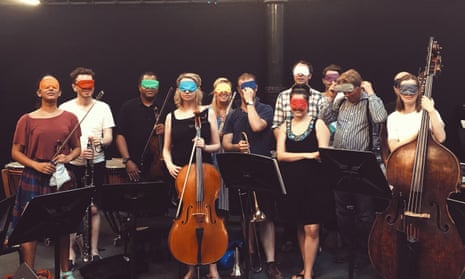“Fade to black.” It’s one of the most ubiquitous lighting directions in existence. If you want to punctuate your final moments and wring every last bit of emotional heft from your material, fade to black.
But when the lights disappear five minutes after the start of the piece and the musicians are still playing? No, you’re not on the Titanic. Georg Friedrich Haas’s In Vain has been hailed by Simon Rattle as “one of the first masterpieces of the 21st century”, and the atmosphere in the hall the night of its UK premiere at the 2013 Huddersfield contemporary music festival was electric. Lighting is an integral part of In Vain, and 20 minutes of it are performed in complete darkness. The musicians seemed to be operating as some sort of pulsating amoeba: the sound expanded and contracted as one, but with impossibly intricate details.
I was in the audience that November night and the performance had a huge impact on me. As a kid who saved up pocket money to see Red Hot Chili Peppers in huge stadiums, I knew that amazing lighting can transform a performance from a recital to an experience. And here – in this classical concert – the simplest of lighting directions were used to maximum effect.
Several years later, the group I’m part of, Riot Ensemble, commissioned Haas to write a work for us. We found ourselves faced with Solstices, 75 minutes long, which, rather than flirting with overtones and microtones (the notes in between the notes on a regular piano), would live inside them. In addition, the whole piece was to be performed in complete darkness.
The work begins by evoking micro movements on a forest floor, and then seems to move down through the earth into the planet’s core. Whether the audience is pushed back up to ground level or pulled down into the fiery magma is down to one’s own perception.
Sleep masks were step one as we prepared for the premiere in January 2019 at the (aptly named) Dark Music Days festival in Iceland. Simply turning the lights off just didn’t cut it. True darkness comes at a price – and a venue’s willingness to temporarily cover Exit signs, sound desks, and the red lights on movement sensors. The masks were due to come off in the performance, when the darkness was total, but for now, they’d have to do.
Before Haas’s arrival we were feeling confident. We’d done several run-throughs. We handed him his mask and invited him to listen. His first response was: “You have to play all the notes correctly. You certainly cannot play any WRONG notes.” Yikes. There was something peculiarly jarring about receiving a put-down from someone with a fluorescent sleep mask perched on their forehead.
For Haas, the darkness is not a gimmick. His music is full of quarter tones and microtones, elements that sound strange to ears accustomed to western music’s tones and semi-tones. I’m sometimes the only musician playing at a fixed pitch – you can’t micro-tune the vibraphone without getting a circular saw out. Solstices is as much about the gaps between the notes as the notes themselves. Deprived of visual stimulus, you listen much more intently, and what might sound eerie and other becomes normalised. The microtones are not “less” than the regular notes: you hear each sound, each chord, on its own merit.

Playing in pitch black offers particular difficulties for the percussionist. A pianist can feel where their keys are even if the music is extremely complex; a violinist has a constant physical connection with their instrument; a trumpet player always knows where the valves are. For me, holding up four sticks to hit a vibraphone in the dark was a challenge. Most of the instruments I play in Solstices are struck with some kind of mallet. This required some serious focus and some particularly motivational pep talks into the mirror. What Haas was asking surpasses muscle-memory. I needed to discover how to manage absolute physical reproduction; how high up you hold your sticks, exactly where you’ve planted your feet, and quite how sweaty your hands are on any occasion.
Meanwhile, the real physical challenges of Solstices mount as the piece unfolds. The other players remain seated for the duration of the work, but I have to navigate a percussion set-up spread over two rows at the back of the stage. I needed to map out my surroundings and orient myself through a hazardous terrain of drums, cymbals, cardboard tubes and metal bins. However, I did have some references. My grandfather has been completely blind since the age of 21, and his ability to engage in day-to-day tasks that many would think were beyond him gave me confidence that I would find solutions.
That first performance, however, was not without incident. I had told the stewards that it was vital no audience member placed themselves anywhere near my walkway. However, they allowed someone in just as the lights were being extinguished. She was presumably delighted to see an open bit of standing-room in the packed hall. Following the piece’s opening, I began my new “hands-first, feet later” walk to my next station. I suddenly felt not the frame of a bass drum but the neck of an Icelandic audience member, who promptly screamed. I may have screamed, too.
Then there’s the matter of the “cataclysmic interruptions” (Haas’s description). There are three of them in Solstices, and they occur at very precise moments. I’m responsible for two of these, and Haas tasked me to come up with the loudest, most disruptive sounds I could muster. I had the idea of throwing three broken cymbals into a dustbin as forcefully as possible. It’s not only very loud, but it carries a connotation of calamity. The rest of the ensemble respond to this sound with a separate gesture; and it’s only if these are both immediate that the sounds register as intentional and dramatic, rather than clumsy and disastrous. It won’t surprise you to learn that I have missed the bin on more than one occasion. If one of the three cymbals misses, the effect still registers. If, as happened in the dress rehearsal, all three miss the bin, landing instead politely on the foam padding around it – not so good. The panicked silence, as the group had to consider (in pitch darkness) whether this pathetic parp of a sound was worth “responding” to, felt like it lasted the full 75 minutes.
There’s something truly exhilarating about making this music with close colleagues, and with performances of Solstices cancelled throughout 2020, this one will feel very special. Haas asks us to disconnect from everything we know and relinquish control. We’ll see what we discover on the other side. I don’t want to spoil how the piece ends, but this is certainly one instance where a “fade to black” won’t cut it.

Comments (…)
Sign in or create your Guardian account to join the discussion